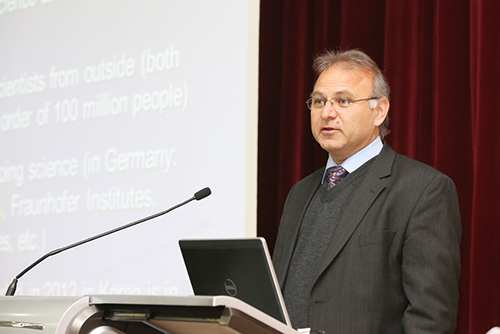On April 8, renowned solar physicist and director of the Max Planck Institute for Solar System Research, Sami Solanki was invited to a colloquium hosted by the Graduate School of Science and Technology Policy to discuss issues on scientific policies. Held at Fusion Hall of the KAIST Institute Building (E4), the director gave a talk on policies behind the Max Planck Institute in Germany, as well as introducing his ongoing solar research.

The talk outlined the principles behind guiding and attracting the best scientists worldwide at the Max Planck Society, which is one of the world’s leading research institutes that incubated many historic scientific breakthroughs. Director Solanki emphasized the distinctive policies from those of other research institutions around the world that made the German institute renowned for its research.
The Harnack principle, the general philosophy on which the Max Planck Institute was founded, was presented at the colloquium. Through this principle, the Max Planck Institute trusts and endows scientific directors with freedom, funding, and academic independence to further expand their scientific endeavors. This high-trust system enables scientists working in the field of basic sciences to focus on long-term goals rather than relying on short-sighted evaluations that can hinder true breakthroughs.
He has also mentioned that the selection process for each research director in the institute has rigorous evaluation criteria and follows heavy critical assessments. As the high-trust system in the Max Planck Institute endows directors with many benefits, the position comes with heavy responsibilities and emphasizes that the benefits should be trusted to the best in the field. It was this principle that made it possible for the Max Planck Institute to be the best worldwide.
The latter portion of the talk introduced his current research in the field of solar astrophysics. His research projects at Max Planck Institute for Solar System Research, such as the SUNRISE project, was shown to the audience. The balloon-borne solar observatory was released in Sweden in 2009, and flew above the thin atmosphere of the Earth to retrieve high-resolution convection structures of the sun’s surface.

